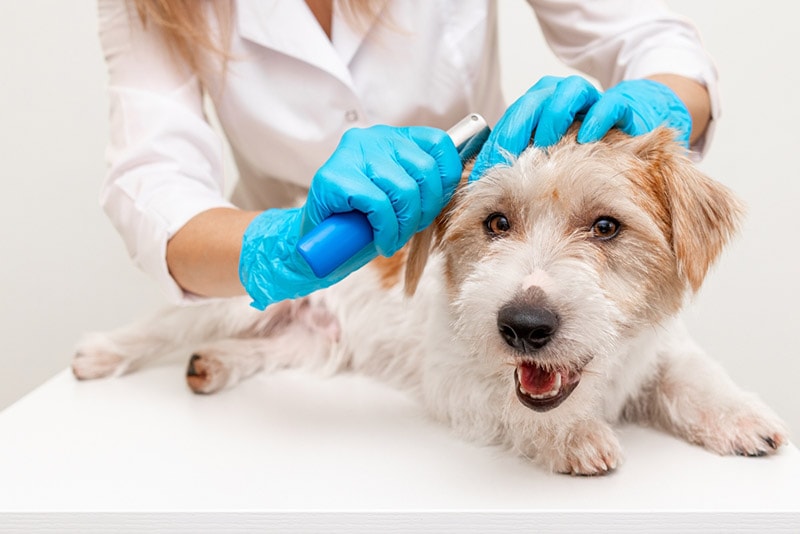How to Clean a Dog Bite in 7 Easy Steps: Vet Approved Advice
By Luxifa Le
Updated on

Animals can be unpredictable, and it’s almost impossible to be entirely removed from the incidence of dog bites if you have a dog. Whether your dog bites you, someone else, or another animal, or your dog is bitten, having a dog increases the likelihood of being involved in one of these incidents.
Here’s a quick guide to treating a dog bite; the steps will be relatively similar no matter who you treat. You want to be sure you’re following all the necessary processes to promote good healing. Always exercise caution and don’t hesitate to seek professional medical attention; it’s better safe than sorry.
The 7 Steps to Clean a Dog Bite
1. Apply Pressure to Any Bleeding Until the Bleeding Stops
Start by applying pressure to any part of the bite that is bleeding. If no part is actively bleeding, consider yourself lucky and skip this step! Keep applying pressure to the wound until it stops actively bleeding. Many dog bites will not do too much damage, but dog bites can do serious damage in severe cases.
Puncture wounds, crush injuries, and open gashes must be seen by a medic, pain relief, antibiotics or stitches may be needed. Superficial wounds may be treated at home.

2. Wash the Wound
Start by washing any dirt or debris away from the wound. This will be important for healing so that the wound is not dirty or contaminated with debris. Flush with copious water, preferably sterile wound flush.
3. Disinfect the Wound
The open wound needs to be kept clean so it can heal properly. You’ll want to disinfect the wound with something gentle on you but tough on germs. Unfortunately, there’s no way for this to be a painless experience. Disinfectants usually contain ethanol or hydrogen peroxide, which causes a burning sensation when applied to the body, especially a sensitive spot like a cut.
Some non-stinging antiseptics like chlorhexidine soap are cheap, effective, and won’t sting like other antiseptics.

4. Collect Rabies Information
We cannot stress enough how important it is to ensure that you collect the rabies tag information of the dog that bit you. If the owner cannot provide rabies tag information, go immediately to the emergency room. If you were bitten by a dog not vaccinated against rabies or whose rabies vaccination status cannot be confirmed, you must receive rabies shots after a dog bite.
When a rabies infection becomes symptomatic, the disease has a 100% mortality rate. No one has ever survived a symptomatic rabies infection. This is true for both humans and animals. So, ensure you collect proper rabies tag information to ensure that you and your dog are not in danger.
5. Apply an Antiseptic Ointment to the Wound
Triple antibiotic ointments containing bacitracin, neomycin, and polymyxin B can be found at almost any drugstore. Ensure that you don’t use any creams containing corticosteroids like hydrocortisone. Antiseptics such as Savlon, Germolene, and Betadine are also suitable.
6. Prevent Any Extra Trauma

If you can wrap a light bandage over the area, it will protect it from any external trauma like bumping on a table or licking. You’ll need to monitor the application and change it frequently if you bandage your dog’s wound.
7. Clean the Wound with an Antiseptic Solution a Few Times a Day
Apply antiseptic ointment until the skin is healed. If the wound worsens at any time or fails to resolve within a week, seek help from a professional of the medical discipline relevant to the bite victim.
 How to Prevent Dog Bites
How to Prevent Dog Bites
The best treatment for a dog bite is prevention. A dog bite that never happens does no damage. Professional dog trainers and other pet care professionals have weighed in on the most effective ways to mitigate threats and reduce the incidence of dog bites.
It starts by understanding the body language of a dog who feels threatened. Dog attacks are most common when the dog feels threatened or intimidated by another dog or person. An aggressive dog may try to make himself look bigger by rolling his shoulders forward. The fur on the back may stand up or puff out, and the tail will be stiff and might be straight up or even wagging.
The whole body will adopt a stiff, straight-legged posture that moves in the direction of the offending creature. The frightened dog may growl, bare its teeth, or bark. Continuing to approach dogs displaying this body language could result in a nasty bite. So, back off and let them decompress.
Nervous dogs may try to make themselves look smaller. They may shrink to the ground in a crouch, lower their heads, lick their lips, tuck their tails between their legs, flatten their ears against the head, and yawn. They may avoid eye contact, stay very still, or try to turn or slowly move away from what they think is a threat. Fearful dogs may also bite if their body language is not headed.
Avoid any dogs showing signs of fear or aggression. Even if these dogs are usually friendly, they’re trying to tell you that they need to be alone right now. Give them space to relax in peace before you try to approach them again.

Safety Tips for Children
Children are particularly susceptible to dog bites because of their impulsiveness and inexperience with dogs. Teaching your children to interact with dogs respectfully and appropriately will save everyone a heartbreaking experience with dog bites. Here are some tips you can teach children:
- Do not approach, touch, or play with a dog that is sleeping, eating, chewing on a toy or a bone, or caring for puppies. Animals are most likely to attack when they’re startled, frightened, or caring for their offspring.
- Never approach a barking, growling, or scared dog. These dogs are likely to attack in self-defense against a perceived threat.
- Teach children the signs of an anxious dog such as those mentioned above. Including whale eye, appeasement licks, and head-turning. They must move away from the dog if they see these signs. Dogs are not people and do not like hugs.
- Do not try to pet unfamiliar dogs without asking permission from the dog’s guardian first. If the guardian permits petting their dog, children should be prepared to let the dog approach in its own time and then sniff their closed hand first and then pet the dog on the shoulders or chest rather than the head.
- Children should be taught never to try and pet dogs who are behind a fence or in a car. Dogs often feel they are compelled to protect their home territory and may be snappier and more disagreeable when they’re in their environment, and you’re outside of it.
- If children see an off-leash dog outside, they should be taught never to approach the dog but to get an adult’s help instead.
- If a loose dog comes near a child, teach them not to run or scream. Instead, avoid eye contact and stand still, like a tree, until the animal moves on. Once the dog loses interest, the child should slowly back away from the dog. Hands down by sides and fists closed, chin tucked down onto chest, and stand still.
- If your child falls or is knocked to the ground by a dog, teach them to curl up in a ball with their knees tucked into their stomach and fingers interlocked behind their neck to protect the neck and ears. If they stay quiet and still, the dog will likely lose interest quickly.
- Teach your children not to try and outrun dogs. If a dog attacks your child, teach them to feed the dog their jacket, bag, books, or anything that the dog can grab onto and put between themselves and the attacking dog.
 Final Thoughts
Final Thoughts
Whether you’re a dog person or not, no one wants to deal with the fallout of a dog bite. But it’s almost inevitable to be at least in your periphery if you have a dog. So, learning how to treat the wounds effectively will make the experience easier when it does happen!
See Also:
Featured Image Credit: Parilov, Shutterstock













